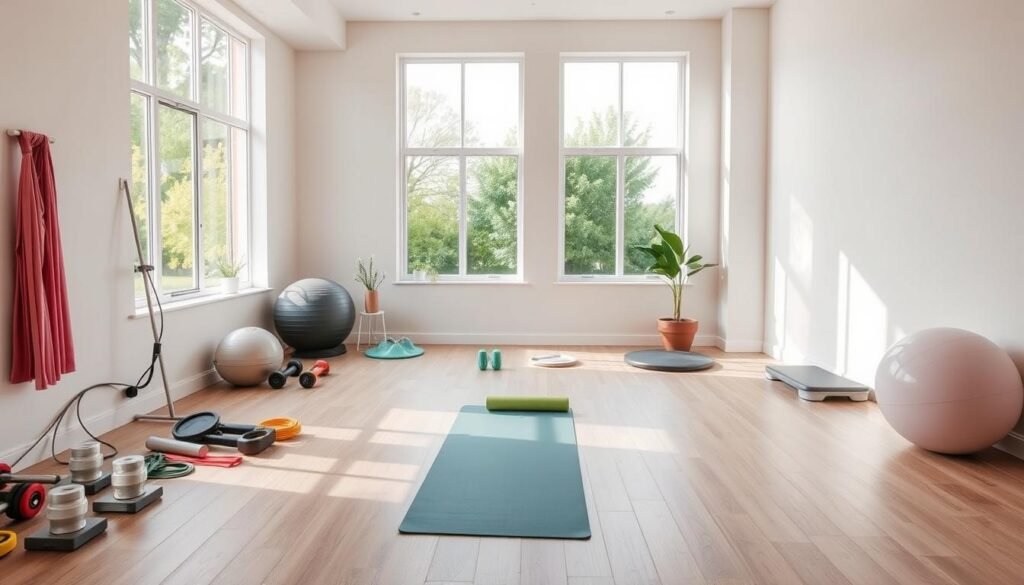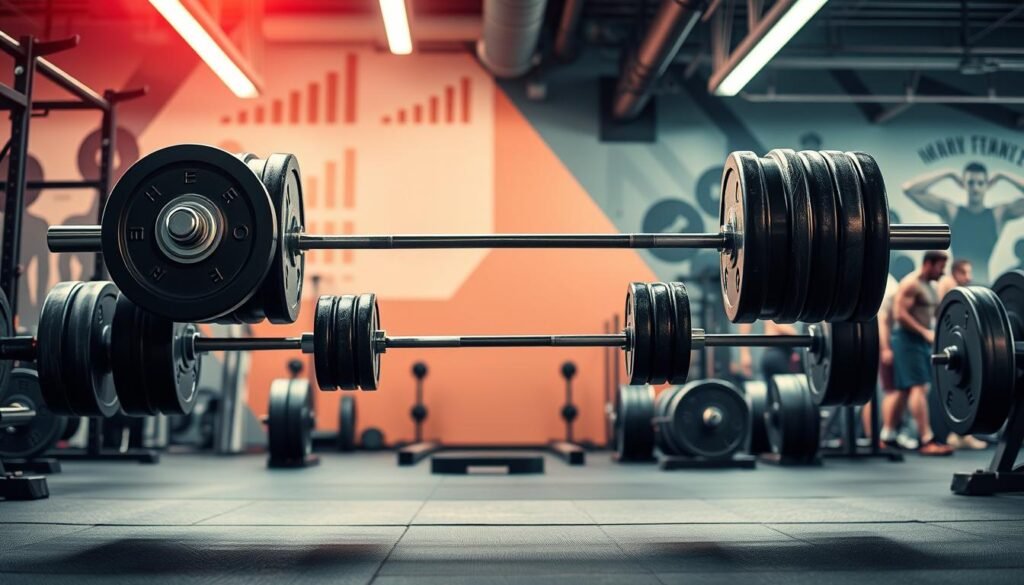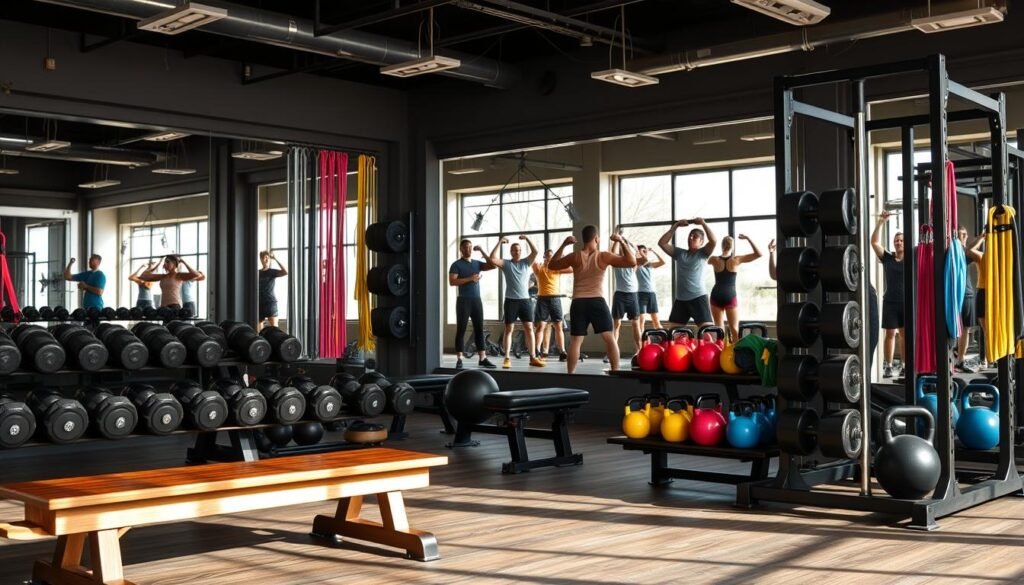Are you ready to change your body and health with strength training? What if you could find a fitness plan that works for everyone, from teens to seniors?
Strength training is more than just lifting weights. It’s a full fitness approach that boosts your body and mind. This guide will teach you strength training tips for muscle growth, better nutrition, and a high-protein diet.
For seniors wanting to keep muscle, bodybuilders aiming for top shape, or anyone looking to get healthier, strength training is key. Your fitness journey begins here with proven, science-backed tips to reach your wellness goals.
Key Takeaways
- Strength training benefits people of all ages and fitness levels
- Proper nutrition is key for muscle growth and recovery
- Regular training leads to big health gains
- High-protein snacks help with muscle growth and repair
- Custom workout plans help reach specific fitness goals
Understanding the Fundamentals of Strength Training
Strength training is more than just working out. It’s a way to build muscle, boost health, and change how you move. It’s good for everyone, from beginners to pros. Knowing the basics can make your workouts better.
What is Strength Training?
Strength training uses resistance to build muscle. You can do it in many ways:
- Bodyweight exercises
- Free weights
- Resistance bands
- Weight machines
Benefits of Regular Strength Training
Regular strength training changes your body in amazing ways. Starting at 30, muscle loss begins. But, with strength training, you can:
- Stop muscle loss
- Speed up your metabolism
- Make your bones stronger
- Get better at everyday activities
Key Principles for Success
To get the best results, you need a plan. Supplements help with muscle growth. Keeping track of calories is important for energy. Apps can help with food portions and workouts.
“Strength does not come from physical capacity. It comes from an indomitable will.” – Mahatma Gandhi
| Protein Intake Guidelines | Recommended Amount |
|---|---|
| Sedentary Individuals | 0.81g per kg of body mass |
| Active Muscle Builders | 1.6g per kg of body mass |
| Maximum Protein Absorption | 35g per meal |
Remember, consistency and proper nutrition are key to successful strength training.
Essential Equipment and Workout Spaces
Strength training doesn’t need a lot of money or complicated gear. You can work out at home or in a gym. The right tools can really help, even for older adults looking to build muscle.
Setting up a good workout space is about choosing the right gear and knowing your goals. Start simple and add more as you get better.
Home Gym Basics
Setting up a home gym is easy and won’t break the bank. Here are the basics:
- Resistance bands (versatile and compact)
- Dumbbells in various weights
- Exercise mat
- Stability ball
- Foam roller for recovery
Gym Equipment Guide
When picking gym equipment, choose what helps you reach your fitness goals. Seniors looking to keep their muscle should pick low-impact, controlled movements.
| Equipment Type | Benefits | Recommended For |
|---|---|---|
| Resistance Machines | Controlled movements, reduced injury risk | Beginners, seniors |
| Free Weights | Improved muscle coordination | Intermediate to advanced |
| Cable Machines | Versatile, adjustable resistance | All fitness levels |
Choosing the Right Weights
Picking the right weights is key for effective workouts. Start with what you can handle and add more as you get stronger. For meals that help build muscle, try a fitness meal delivery service with lots of protein.
*”The right equipment can transform your workout from mundane to motivating.”*
Remember, it’s not about how much gear you have. Focus on doing the exercises right and keep getting better.
Proper Form and Technique Basics
Learning proper form is key for a good senior fitness plan. Your technique affects how well you do in weight training and lowers injury risk in resistance exercises.
When you start strength training, focus on these important technique points:
- Move slowly and with control
- Keep the right posture during each exercise
- Breathe the same way during movements
- Begin with lighter weights to get the form right
“Technique trumps weight every single time in resistance training for seniors.” – Fitness Expert
For older adults, making changes is vital. The Romanian deadlift is safer than traditional deadlifts, great for those with limited hip mobility. Experts suggest doing power training twice a week with lighter weights. Aim for 3 sets of 6 reps.
Important technique tips for weight training include:
- Take 2 seconds to lower the weight
- Go up fast in 1 second
- Focus on muscle engagement
- Avoid jerky or momentum-based movements
Remember, proper form helps you get the most out of your workout while keeping you safe. Listen to your body and keep movements controlled. This way, you can build a safe and effective fitness plan that helps keep your muscles strong.
Building Your First Workout Routine
Creating your first strength training program can seem tough. But with the right steps, you’ll lay a strong foundation for fitness. It’s important to focus on bodybuilding nutrition for seniors and a high-protein diet for muscle growth.

Your first workout should include full-body exercises that work many muscles at once. Start simple and gradually get tougher.
Upper Body Exercises
For your upper body, include these key exercises:
- Push-ups (modified if needed)
- Dumbbell chest press
- Resistance band rows
- Overhead shoulder press
Lower Body Movements
Lower body exercises are key for keeping your muscles and mobility strong. Focus on:
- Bodyweight squats
- Step-ups
- Leg press machine
- Walking lunges
Core Strengthening Exercises
A strong core is vital for overall fitness, as it supports your body’s nutrition in the golden years:
- Planks
- Bird dogs
- Stability ball crunches
- Seated twists
“Strength training is not about age, it’s about commitment and smart nutrition.” – Fitness Expert
| Exercise Type | Sets | Repetitions | Rest Period |
|---|---|---|---|
| Upper Body | 3 | 8-12 | 60-90 seconds |
| Lower Body | 3 | 10-15 | 90 seconds |
| Core | 2-3 | 12-15 | 45-60 seconds |
Always listen to your body and keep proper form. Also, don’t forget about nutrition. A diet rich in 1 to 1.5 grams of protein per pound of bodyweight helps with muscle growth and recovery.
Strength training for seniors Bodybuilding diet Fitness nutrition High-protein
As you get older, strength training becomes more important. Muscle loss is a natural part of aging, but you can fight it with the right diet and exercise. About 30% of adults over 70 struggle with simple movements, showing how vital muscle strength is.
To build lean muscle as a senior, you need a plan. Muscle strength usually peaks in your 30s and then goes down. The good news? Your body can keep building muscle, no matter your age.
“Physical activity is not about age, it’s about capability and commitment.” – Fitness Expert
For seniors doing strength training, nutrition is key:
- Daily protein intake: 56 grams for men, 46 grams for women
- Calcium-rich foods: Three servings daily
- Daily fiber intake: 30 grams for men, 21 grams for women
- Hydration: Six to eight glasses of water per day
The Centers for Disease Control and Prevention say older adults should do muscle-strengthening exercises two times a week. This can help fight muscle loss and lower fall risks.
Strength training for seniors has many benefits:
- Improved bone density
- Enhanced balance
- Boosted metabolism
- Reduced risk of chronic diseases
It’s never too late to begin. Even simple exercises can greatly improve your health. They help you stay independent and enjoy life as you age.
Progressive Overload and Training Adaptation
Strength training is a journey of getting better every day. To reach your fitness goals, it’s key to understand progressive overload. This method keeps your muscles challenged, helping them grow.

Progressive overload means increasing the challenge in your workouts. Nutritional supplements help by giving your muscles what they need to recover and grow.
Understanding Weight Progression
Increasing weights wisely is important to avoid injuries:
- Don’t increase weights by more than 10% each week.
- Slowly add more weights, sets, or reps.
- Use fitness apps to track your progress.
Recovery and Rest Periods
Rest is just as important as working out. Your muscles grow when you’re resting, not when you’re exercising. Good rest helps with:
- Muscle repair
- Energy refilling
- Hormone balance
Avoiding Training Plateaus
To avoid hitting a wall, manage your calories and mix up your workouts. Try these:
- Change the order of your exercises.
- Adjust how hard you’re working out.
- Use periodization to keep things interesting.
“The key to continuous improvement is systematic, incremental challenge.” – Strength Training Expert
| Training Phase | Weight Increase | Interval Progress |
|---|---|---|
| Week 1 | 100 lbs | 8 intervals |
| Week 4 | 105 lbs | 10 intervals |
| Week 8 | 110 lbs | 12 intervals |
Remember, progressive overload is a personal journey. Listen to your body, keep track of your progress, and adjust your plan as needed.
Common Mistakes and Safety Precautions
When you start strength training, your safety is key. Always talk to a doctor before starting a new workout plan. This is very important if you have health issues or past injuries.
“Knowledge is your best protection in the gym” – Fitness Expert
Knowing common mistakes can help you avoid them. It’s important to control your portions and know what you’re eating. This helps you do well in your workouts.
- Warm up properly before each workout
- Use correct form to prevent injuries
- Listen to your body’s signals
- Avoid overtraining
Many athletes find it hard to understand nutrition. Fitness meal delivery services can help. They offer balanced meals that fit your training needs.
Here are some safety tips:
- Start with lighter weights and progress gradually
- Rest between workout sessions
- Stay hydrated
- Use proper equipment
Remember, quality trumps quantity in strength training. Good technique and controlled movements are more important than heavy weights.
Studies show that eating 1.4 – 2.0 g/kg body weight of protein daily helps muscles grow. But, watch how your body reacts and adjust your diet as needed.
Tracking Progress and Setting Goals
Starting a fitness journey is more than just going to the gym. It’s important to track your progress, which is key for seniors looking to build muscle or follow a fitness plan.
Measuring Success in Your Fitness Journey
For older adults, tracking progress in weight training is essential. Here are some ways to measure success:
- Strength assessments using weight increments
- Body composition analysis
- Functional movement evaluations
- Mobility and flexibility improvements
“Success is not about perfection, but consistent progress.”
Adjusting Your Training Program
Your fitness plan should be flexible. Tracking your progress helps you change exercises as needed. About 70% of successful fitness plans involve making adjustments based on how your body responds.
| Tracking Method | Frequency | Purpose |
|---|---|---|
| Strength Tests | Every 4-6 weeks | Measure muscle mass progression |
| Body Measurements | Monthly | Track physical changes |
| Performance Logs | After each workout | Monitor exercise performance |
Long-Term Planning Strategies
Creating a lasting strength training plan means setting achievable goals. Research shows that older adults can build muscle with regular, progressive weight training. Your long-term plan should include gradual increases in intensity and complexity.
Nutrition and Recovery Strategies
Nutrition is key for muscle growth and recovery, vital for seniors doing resistance exercises. Your body needs the right food to fix muscles and stay strong.
“Proper nutrition is the foundation of muscle recovery and strength development.” – Sports Nutrition Expert
For seniors into bodybuilding, here are some important diet tips:
- Prioritize high-protein diet for muscle growth
- Balance macronutrients for optimal recovery
- Time meals around workout schedules
Protein is essential for keeping and growing muscles. Older adults need 1.2 to 1.6 grams of protein per kilogram of body weight daily. This helps fight muscle loss that comes with age.
| Macronutrient Split | Carbohydrates | Protein | Fats |
|---|---|---|---|
| Aging Athletes Option 1 | 30% | 40% | 30% |
| Aging Athletes Option 2 | 25% | 35% | 40% |
Recovery isn’t just about food. Rest days help muscles heal, avoid overtraining, and lower injury risk. Make sure to alternate muscle groups and get enough sleep for the best recovery.
Don’t forget to drink water, eat protein soon after working out, and listen to your body’s needs during your strength training.
Conclusion
Your journey in strength training is more than just a workout. It’s a key to staying active and building lean muscle as you age. Studies show that muscle loss starts in your 40s, affecting your health and how you move.
Good nutrition is vital for your strength training goals in the golden years. Eating enough protein (1.5–1.6 g/kg/day) can help older adults build muscle. The National Strength and Conditioning Association suggests doing strength training two to three times a week to keep muscle and strength.
With the right exercises and nutrition, you can fight muscle loss and live better. As the senior population grows to 30% by 2050, staying fit is more important than ever. It helps you stay independent and enjoy life fully.
Committing to strength training is a smart choice for your future. It builds strength, keeps you independent, and ensures a lively life in your golden years. Begin your journey today and see how strength training can change your life.





